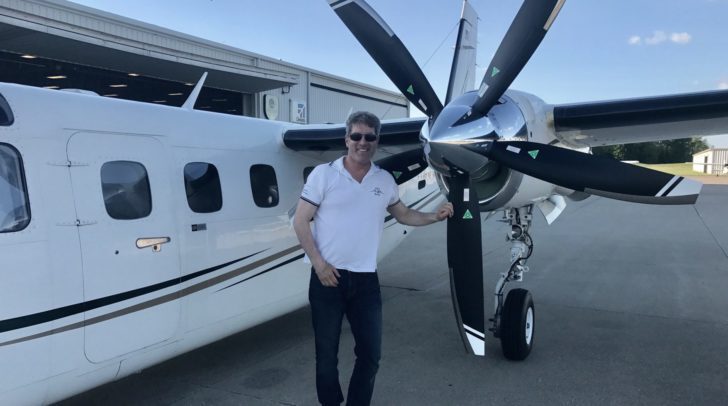
He’s dubbed it Citizen of the World.

Beginning this December, new Twin Commander owner Robert DeLaurentis is embarking on a trip that has never been achieved. He’ll be flying his 900 around the world from pole to pole.
The real estate broker and author has been preparing himself and the airplane the past 18 months. A flight with such extreme temperatures, long overwater legs, and remote airports requires an incredible amount of coordination and preparation. But most of the time has been spent taking a standard 690D and converting it to an airplane that can easily fly non-stop for more than 17 hours. From fuel tanks to panel, the airplane has been extensively modified for the trip.
The route will take DeLaurentis 26,000 miles, with stops in more than 20 countries. He is planning to leave San Diego sometime in early December, and fly over the South Pole on January 1, 2019. His flight plan takes him south through Latin America, from the tip of South America to the South Pole and back, then across the Atlantic Ocean to Africa, up through the Middle East, through Europe, up over the North Pole, down through Greenland, and back to the United States, stopping in Oshkosh for EAA’s show in late July.
The longest and most dangerous leg of the trip is flying over the South Pole. From the tip of Chile, over the pole, and back is more than 17 hours, and will require a massive amount of extra fuel. To accomplish the leg, DeLaurentis has added the capability to carry more than 900 gallons of additional fuel housed in six fuel tanks within the cabin, and increased the maximum takeoff weight for full-fuel operations by 40 percent. He hopes to get 5,000 nautical miles of range out of his Twin Commander.

To achieve the most efficient fuel burn, DeLaurentis added RVSM certification. He plans to cruise most legs at 35,000 feet. He has also shed weight with other system upgrades, and improved efficiency as the launch customer for MT’s five-blade scimitar composite propellers on the Twin Commander.
DeLaurentis has experience with long-distance flights. In 2015 he flew around the world in a Piper Malibu Mirage, a trip he embarked on with just a few years of flying experience and less than a thousand hours of time in the air.
Numerous mechanical problems on the flight and a desire to do longer travel after this upcoming mission had DeLaurentis searching for a new platform. He chose the 900 in part because of the Honeywell TPE-331 engines with the Dash 10T upgrade. “You really have to start with the engines,” he said. That narrowed his choices down to the Mitsubishi MU-2, certain King Air models, and the Metroliner. He chose the Twin Commander because of its service ceiling, range, and robust support network.
Eagle Creek Aviation sold DeLaurentis the airplane, and he’s been upgrading it ever since. He purchased the airplane with high-time engines, but they were on a program, which allowed him to overhaul soon after purchase.
In the panel he made the unusual decision to switch out new Garmin equipment for Avidyne avionics. DeLaurentis said that after researching the various options he liked the Avidyne’s buttons and knobs, which he thinks could be more robust on such a trip. Avidyne also simulated the polar crossings successfully, something DeLaurentis said others couldn’t do. “And most importantly, pilots need choices,” he added The Avidyne unit also interfaced with an enhanced vision system installed and field approved.
The panel isn’t all new technology. An ADF and HF radio were added for remote and overwater operations. Twin Commander Aircraft has provided guidance, technical expertise, and will be providing support with its global service center network as he makes his way around the world.
The ownership process, multiple upgrades, and even learning to fly the airplane has been a challenge for the relatively new twin-engine pilot. He took training at Simcom and then flew with an instructor for 25 hours. By the time he leaves for the poles, DeLaurentis will have about 250 hours in the airplane, and about 200 hours on his newly overhauled engines.
DeLaurentis is focused on promoting aviation around the world, as well as carrying a message of togetherness and peace. He said the flight is for One People, One Planet, and One Plane. Along the way he’ll carry science experiments for NASA and university researchers, try to inspire school kids, and spread the message of general aviation—and the capabilities of Twin Commanders—wherever he goes. “This is the about the coolest thing I thought you could do with a GA airplane,” he said.
